towing AUDI A3 2012 Owner´s Manual
[x] Cancel search | Manufacturer: AUDI, Model Year: 2012, Model line: A3, Model: AUDI A3 2012Pages: 280, PDF Size: 70.11 MB
Page 177 of 280
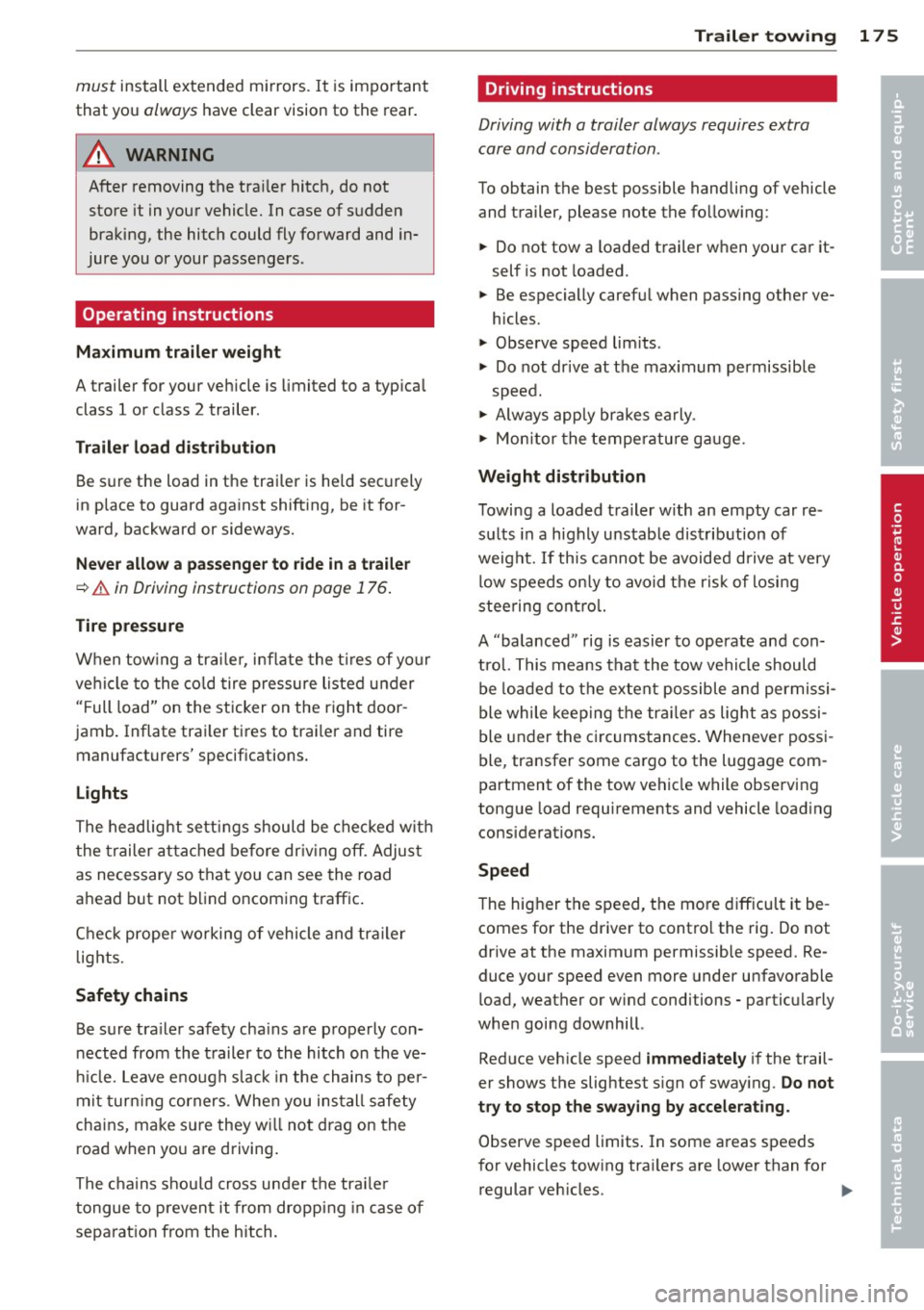
must install extended mirrors. I t is important
that you
always have clear vision to the rear.
A WARNING -
After removing the tra ile r hitch, do not
store it in your vehicle. In case of s udden
braking , the hitch could fly forward and in
jure you or your passengers .
Operating instructions
Maximum trailer weight
A trailer for your ve hicle is limited to a typica l
class 1 o r class 2 trailer.
Trailer l oad di stribut ion
Be s ure the load in the trai ler is he ld sec urely
in place to guard aga inst shift ing, be it for
ward, backward or sideways.
Never allow a passenger to ride in a trailer
~ &. in Driving instructions on page 176 .
Tire pressure
When tow ing a tra ile r, i nflate the ti res of yo ur
ve hicl e to the co ld tire pressure listed u nder
"Full load" on the sticker on the r igh t door
jamb . Inflate trai ler ti res to trai ler and tire
manufacturers' specifications.
Lights
The he adlig ht setti ngs should be che cked w ith
the trailer a ttached be fore dr iv ing off . Adjus t
as necessary so that you can see the road
a h ead but not blind o ncoming traff ic .
C hec k prope r wo rking of vehicle a nd t ra ile r
lights.
Safety chains
B e s ure tra ile r safe ty cha ins are p roperly con
nected from the t railer to the hitch on the ve
hicl e. Leave e no ugh s lack in the chains to pe r
mi t turning corners . Whe n you ins tall safe ty
ch ains, m ake s ure they w ill not drag on the
road when yo u are driving .
The c ha ins shou ld cross un der th e tra ile r
t ongue to prevent it from droppi ng in case of
separat ion from the h itch.
Trailer towin g 175
Driving instructions
Driving with a trailer always requires extra
care and consideration .
To obtain the best possible handli ng of vehicle
and trailer, please note the fo llow ing:
... Do not tow a loaded t railer w hen you r ca r it
self is not loaded .
... Be especially caref ul when pass ing other ve
hicles .
... Obse rve speed lim its .
... Do not dr ive at the maximum permissib le
speed.
... Always app ly brakes e arly .
... Mon itor the tempe rature g auge.
Weight distribution
Towing a loaded t railer w ith an em pty car re
su lts in a highly unstab le distrib ution of
weig ht. If th is cannot be avoided d rive at very
l ow speed s on ly t o a void t he ri sk of losi ng
stee ring cont rol.
A "ba lanced " rig is easier to operate and con
tr ol. Th is means t hat the tow vehicle should
b e lo ade d to t he e xten t possible and per miss i
ble while keep ing t he tr ailer a s light as possi
ble under the c ircu mstances . Wheneve r poss i
ble, transfe r some ca rgo to the lugga ge com
partment of the tow vehicle w hile obse rv in g
tong ue load requ irements and vehicle load ing
consideratio ns.
Speed
The higher the speed, the mo re di fficu lt it be
comes for the driver to contro l the rig . Do not
drive at the maximum permissib le speed. Re
duce your speed even more under unfavo rable
load, weather or wind conditions - partic ularly
whe n going downhill .
Red uce veh icle speed
immediately if the trail
er shows t he slig htest s ign of sway ing.
Do not
try to stop the swaying by accelerating .
Observe speed limits . In some a reas speeds
f or vehicles tow ing tra ile rs a re lower than for
r egular veh icles .
•
•
Page 178 of 280
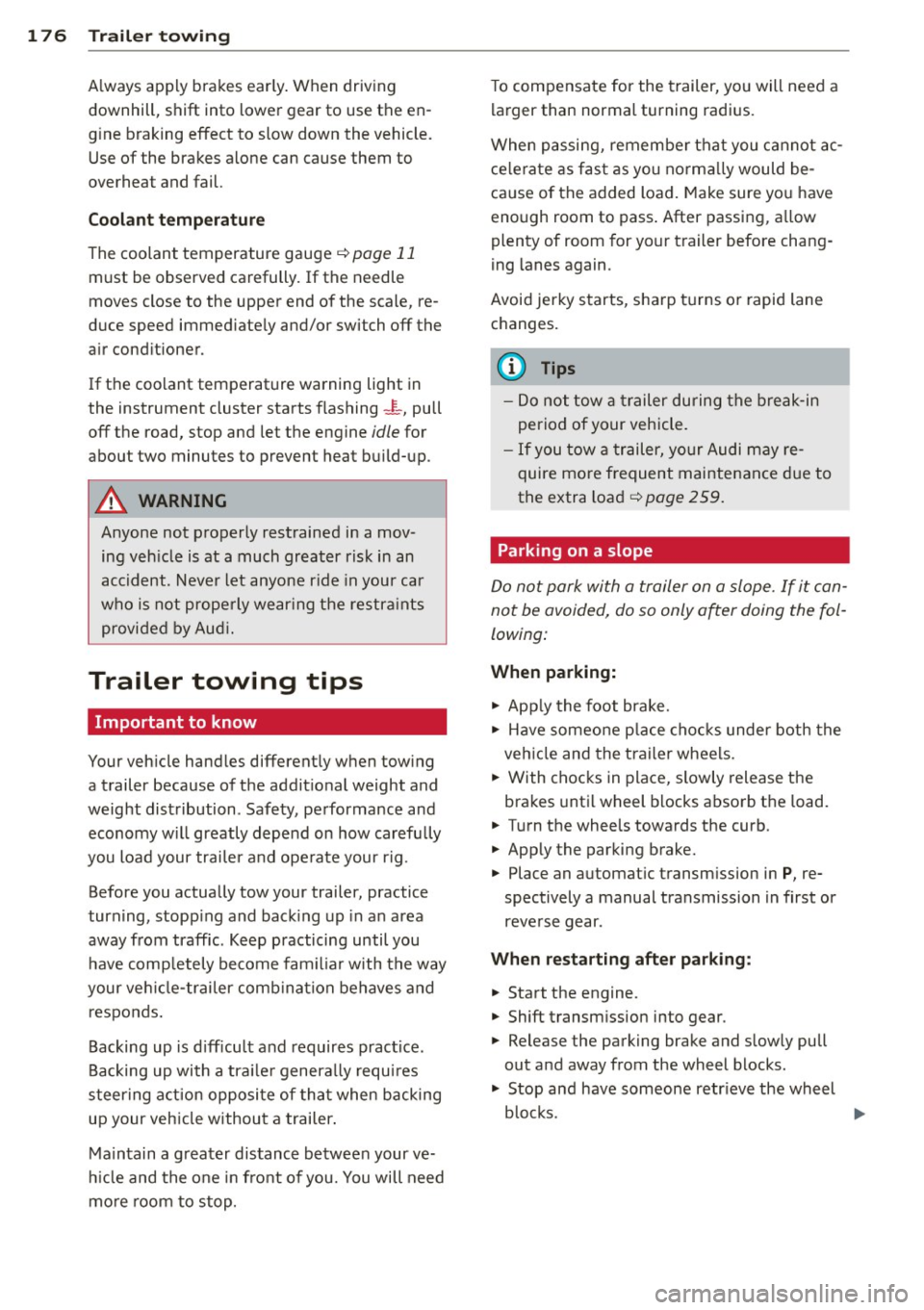
176 Trailer towing
Always app ly bra kes early . When driving
downhill, shift into lower gear to use the en
g ine braking effect to slow down the vehicle.
Use of the brakes alone can cause them to
overheat and fail.
Coolant temperature
The coolant temperature gauge ¢ page 11
must be observed carefully. If the needle
moves close to the upper end of the scale, re
duce speed immed iate ly and/or switch
off the
a ir cond itioner.
If the coolant temperature warning light in
the instrument cluster starts flashing
J_, pull
off the road, stop and let the engine idle for
about two minutes to prevent heat build-up.
A WARNING
Anyone not properly restrained in a mov
ing veh icle is at a much greater risk in an
accident . Never let anyone r ide in your car
who is not prope rly wear ing the restra ints
provided by Aud i.
Trailer towing tips
Important to know
Your veh icle handles different ly when towing
-
a trailer because of the addit io nal weight and
weight distribution . Safety, performance and
economy w ill greatly depend on how carefu lly
you load your trai ler and ope rate your rig .
Before you actually tow your trailer, practice
turn ing, stopp ing and back ing up in an area
away from traffic. Keep practicing until you have comp letely become fam iliar w ith the way
your ve hicle-trai ler comb ination behaves and
responds .
Backing up is d iff icu lt and requires practice .
Backing up with a tra ile r genera lly requ ires
steer ing act ion opposite of tha t when backing
up your veh icle without a trailer .
Ma intain a g reater distance between your ve
h icle and the one in fro nt of you. You will need
mo re room to stop. To compensate for the trailer, yo
u will need a
larger than normal turning radius.
When passing, remember that you cannot ac
ce le rate as fas t as you no rma lly would be
cause of the added load. Make sure yo u have
enough room to pass . After passing, a llow
plenty of room for your trailer before chang
ing lanes again.
Avoid jerky starts , sharp turns or rapid lane
changes.
(D Tips
- Do not tow a trailer during the break -in
period of your vehicle.
- If you tow a trailer, yo ur Audi may re
quire more frequent maintenance due to
the extra load ¢
page 2 59.
Parking on a slope
Do not park with a trailer on a slope . If it can
not be avoided, do so only after doing the fol
lowing:
When parking:
.,. App ly the foot brake.
.. Have someone p lace cho cks under both the
veh icle and the trailer wheels.
.. With chocks in place, slowly release the
brakes unti l wheel b locks absorb th e load.
.. Turn the whee ls towards the cu rb.
.. App ly the parking brake.
.. Place an automat ic transm ission in
P, re
spectively a manual transmission in first or
reverse gear .
When restarting after p ark ing:
.. Start the engine.
.. Shift transm ission into gear .
.. Release the parking brake and slowly pull
out and away from the wheel blocks.
.,. Stop and have someone retr ieve the wheel
b locks .
Ill-
Page 224 of 280
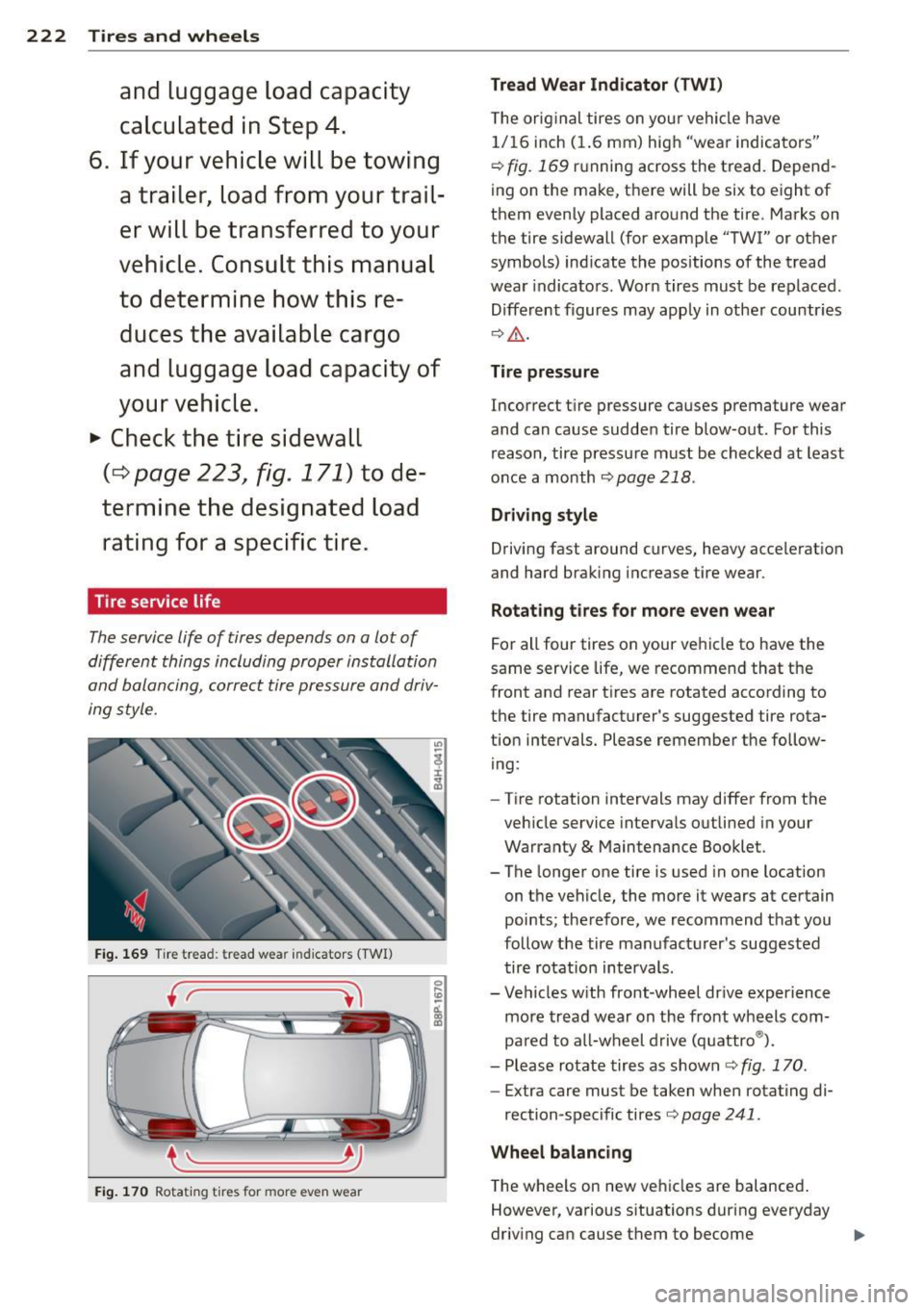
222 Tires and wheels
and luggag e loa d cap acit y
c alcul ated in St ep 4.
6 . If your v ehi cle will b e towing
a trail er, load fro m your trail
er will b e tr ansferr ed to your
vehi cle. Con sult thi s manual
to determin e how thi s re
d uces the available cargo
and luggage lo ad capacity of
y our vehicle.
..., Check the tire sidewall
(q page 223, fi g . 171) to de
termine the d esignated lo ad
rating f or a specific tire.
Tire service life
The service life of tires depends on a lot of
different things including proper installation
and balan cing, correct tire pressure and driv
ing style.
Fig. 16 9 Tire tread: trea d wea r in di cators (TWI)
fr
Fig. 1 70 Rotat ing t ires for more even wear
Tread Wear Indicator (TWI)
The or ig inal tires on you r vehicle have
1/ 16 inch ( 1.6 mm) hig h "wear indica tors"
c::> fig. 169 ru nning across the tread . Depend
ing on the ma ke, there will be six to eight of
them even ly placed aro und the tire. Marks on
the tire sidewall (for example "TWI" or other
symbols) ind icate the positions of the tread
wear indica to rs. Wor n tires must be replaced .
Different figures may apply in other countr ies
c::> .&_ .
Tire pressure
Incor rect t ire pressure causes premature wea r
and can cause sudde n tire blow-out . For this
reason, tire pressu re must be checked at least
o nce a month
c::> page 218 .
Driving style
Driving fast around c urves , heavy accelerat ion
and hard braking increase tire wear .
Rotating tires for more even wear
F or all four tires on your ve hicle to have the
same service life, we recomme nd that the
front and rear tires are rotated accord ing to
the tire manufact urer's suggested tire rota
tion intervals. Please remembe r th e follow
i ng:
- T ire rotation intervals may differ from the
veh icle service intervals o utli ned in your
Warranty
& M ain tena nce Booklet .
- The longer one tire is used in one location
on t he vehicle, the more it wears at certain
points; the refore , we recommend that you
follow the tire man ufac turer's suggested
tir e rotat ion intervals.
- Vehi cles with front -wheel dr ive experience
more trea d wear on the fro nt wheels com
pa red to all-wheel d rive (q uattro ®).
- Please rotate tires as shown
c::> fig . 170 .
-Extra care must be taken when rotating di-
rection -spec ific tires
c::> page 241 .
Wheel balancing
The wheels on new ve hicles are balanced .
However, various s ituations during everyday
driv ing ca n cause them to become
...
Page 238 of 280
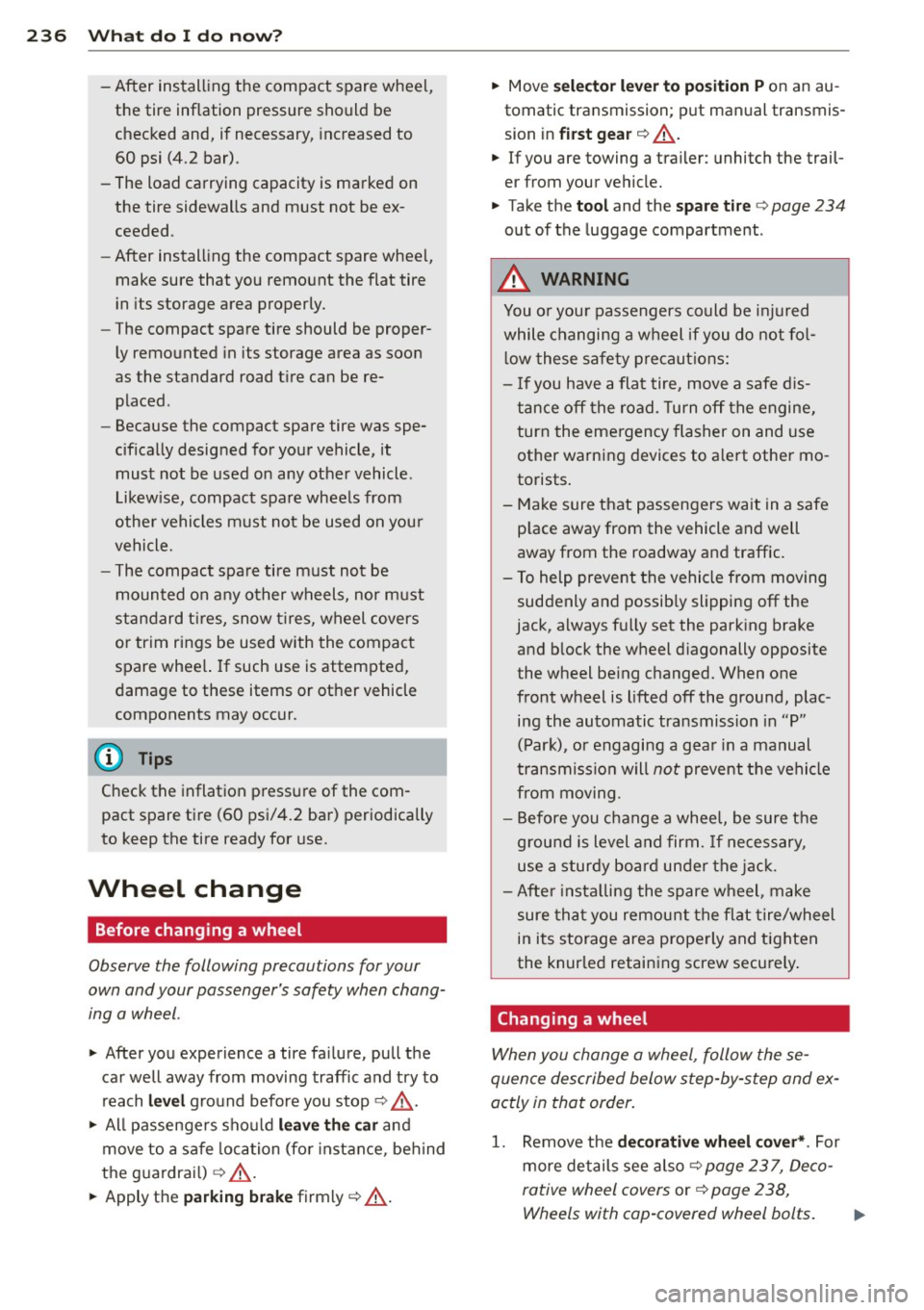
236 What do I do now?
-After installing the compact spare wheel,
the tire inflation pressure should be
checked and, if necessary, increased to
60 psi (4.2 bar).
- The load carrying capacity is marked on
the tire sidewalls and must not be ex
ceeded.
- After installing the compact spare wheel,
make sure that you remount the flat tire
in its storage area properly.
- The compact spare tire should be proper
ly remounted in its storage area as soon
as the standard road tire can be re placed .
- Because the compact spare tire was spe
cifically designed for your vehicle, it must not be used on any other vehicle .
Likewise, compact spare wheels from
other vehicles must not be used on your
vehicle.
- The compact spare tire must not be
mounted on any other wheels, nor must
standard tires, snow tires, wheel covers
or trim rings be used with the compact
spare wheel. If such use is attempted,
damage to these items or other vehicle
components may occur .
(D Tips
Check the inflation pressure of the com
pact spare tire (60 psi/4.2 bar) periodically
to keep the tire ready for use.
Wheel change
Before changing a wheel
Observe the following precautions for your
own and your passenger's safety when chang
ing a wheel .
.. After you experience a tire failure, pull the
car well away from moving traffic and try to
reach
level ground before you stop c:> ,&. .
.. All passengers should leave the car and
move to a safe location (for instance, behind
the guardrail)
c:> _&. .
.. Apply the parking brake firmly c:> _&. .
.. Move selector lever to position Pon an au
tomatic transmission ; put manual transmis
sion in
first gear c:> _&..
.. If you are towing a trailer : unhitch the trail
e r from your vehicle.
.. Take the
tool and the spare tire c:> page 234
out of the luggage compartment .
.&, WARNING
You or your passengers could be injured
while changing a wheel if you do not fol
low these safety precautions:
- If you have a flat tire, move a safe dis
tance off the road. Turn off the engine,
turn the emergency flasher on and use
other warning devices to alert other mo
torists.
- Make sure that passengers wait in a safe place away from the vehicle and well
away from the roadway and traffic .
- To help prevent the vehicle from moving suddenly and possibly slipping off the
jack, always fully set the parking brake
and block the wheel diagonally opposite
the wheel being changed. When one
front wheel is lifted off the ground, plac
ing the automatic transmission in "P"
(Park) , or engaging a gear in a manual
transmission will
not prevent the vehicle
from moving.
- Before you change a wheel, be sure the
ground is level and firm. If necessary,
use a sturdy board under the jack.
- After installing the spare wheel, make
sure that you remount the flat tire/wheel
in its storage area properly and tighten
the knurled retaining screw securely.
Changing a wheel
-
When you change a wheel, follow these
quence described below step-by-step and ex
actly in that order .
1. Remove the decorative wheel cover*. For
more details see also
c:> page 23 7, Deco
rative wheel covers
or c:> page 238,
Wheels with cap-covered wheel bolts.
Page 250 of 280
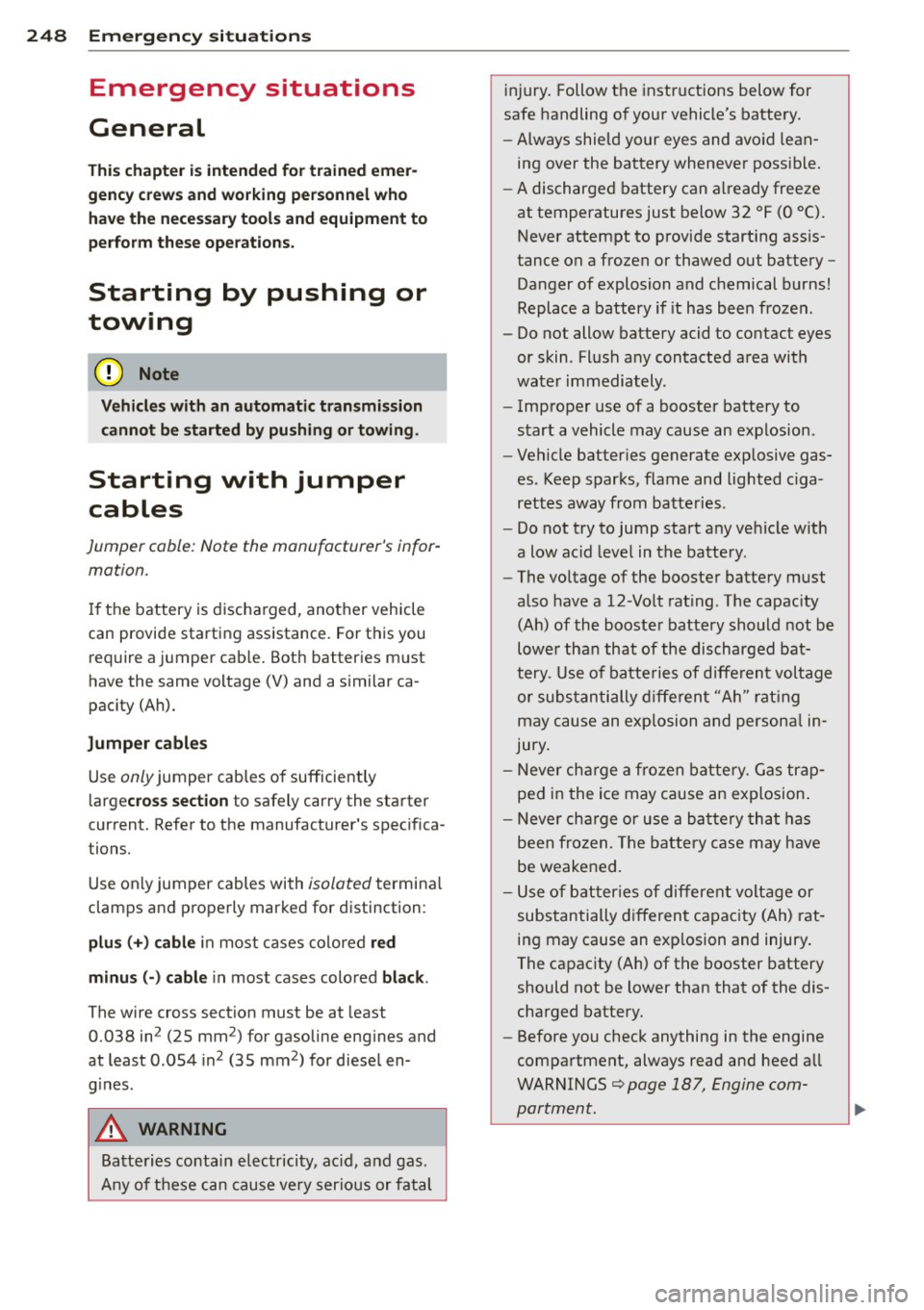
248 Emergency situations
Emergency situations
General
This chapter is intended for trained emer
gency crews and working per sonnel who
have the necessary tools and equ ipment to
perform these ope rations.
Starting by pushing or
towing
Q;) Note
Vehicle s with an automati c transmission
cannot be started by pushing or towing .
Starting with jumper
cables
Jumper cable: Note the manufacturer's infor
mation.
If th e battery is d ischa rged, another vehicle
can provide starting assistance. For this you
req uire a j umper cab le . Both batteries m ust
have the same voltage (V) and a s imilar ca
pac ity (Ah).
Jumper cables
Use only jumper cab les of sufficiently
large cross section to safely carry the sta rter
cur rent. Refer to the manufacturer 's specifica
ti ons.
Use on ly jumper cables with
isola ted termina l
clamps an d properly marke d for distinction :
plus(+) cable in most cases colo red red
minu s(-) cable
in most cases colo red black .
The wire cross section must be at least
0.038 in
2 (25 mm2 ) for gasoline eng ines and
at least 0.054 in
2 (35 mm2
) for diese l en
gines .
A WARNING
Batte ries co ntain e lec tricity, ac id, a nd gas .
Any of these can cause ve ry ser io us or fatal i
njury . Follow the instructions below for
safe handling o f your vehicle's battery.
- Always shie ld your eyes and avo id lean-
ing over the battery wheneve r poss ib le.
- A discharged battery can a lready freeze
at temperatures just be low 32 °F (0 °() .
N ever attempt to provide start ing ass is
tance on a frozen or thawed out batte ry -
Da nger of explosion and chemical burns!
Replace a battery if it has bee n froze n.
- Do not allow battery acid to contact eyes
or skin . Fl ush a ny con tacted a rea with
wa te r immediat ely .
- Imp rope r use of a booster battery to
start a vehicle may cause an ex plosion .
- Vehicle batter ies ge nerate explosive gas
e s . K eep spar ks, flame and lighted c iga
r e ttes away from ba tteries.
- Do not try to ju mp start a ny ve hicle w it h
a low ac id leve l in the battery .
- The vo ltage of the bo oste r batte ry m ust
a lso have a 12-Vo lt rat ing. T he capacity
(A h) of the booste r battery sho uld not b e
lowe r than that of the discharged bat
tery . U se o f batte rie s of d iffe ren t voltage
or subs tan tia lly diffe ren t "Ah" rat ing
may c ause an exp losion and person al in
jury .
- N ever ch arge a fr oze n b atte ry. Gas t rap
ped in the i ce may c ause an ex plosion .
- N ever ch arge or use a batt ery th at h as
been frozen . T he battery case may have
be weake ned.
- Us e of batt erie s of diff ere nt vol tage or
subs tanti ally diff eren t ca pac ity (Ah) rat
in g may cause an exp losion and injury.
The ca pac ity ( Ah) of the booster battery
should not be lower than that of the dis
charged batte ry.
- Before you check anythin g in the engine
compa rtment, always read and heed a ll
WAR NIN GS¢
page 187, Engine com
partment.
Page 253 of 280
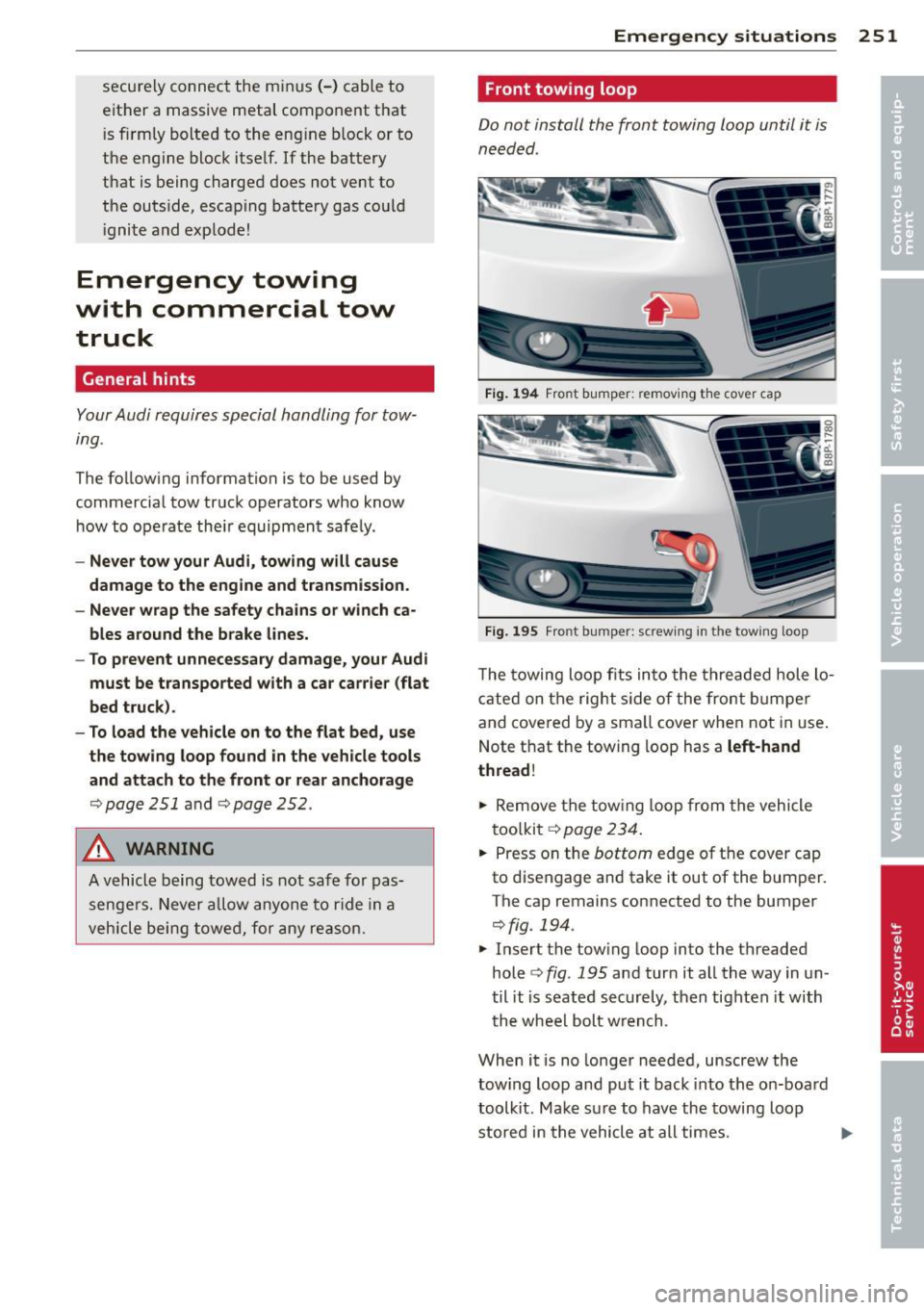
securely connect the minus(- ) cable to
either a massive metal component that
i s firm ly bolted to the eng ine b lock or to
the engine block itself. If the battery
that is being charged does not ve nt to
the outside, escaping battery gas cou ld
i gnite and explode!
Emergency towing
with commercial tow
truck
General hints
Your Audi requires special handling for tow
ing .
The fol low ing information is to be used by
commercial tow truck operators who know how to ope rate their equipment safe ly.
- Never to w your Audi, towing will cause
damage to the engine and t ransmission.
- Never wrap the safety chain s or winch ca
bles around the br ake lines.
- To pre vent unnecessary damage , you r Audi
must be transported with a car carrie r (flat
bed truck ).
- To load the vehicle on to the flat bed, use
the towing loop found in the veh icle tools
and attach to the front or rear anchorag e
¢page 251 and ¢page 252.
..&, WARNING
A vehicle being towed is not saf e for pas
senge rs. Never a llow anyone to r ide in a
vehicle being towed, for any re ason.
Emergenc y situ ation s 251
Front towing loop
Do not install the front towing loop until it is
needed .
Fig . 194 Fro nt bu mper: re m ov ing t he cover ca p
Fig. 195 Fro nt bump er: s crew ing in t he tow ing loo p
The towing loop fits into the threaded hole lo
cated on the right s ide of the front b umper
and covered by a sma ll cover when not in use .
Note that the towing loop has
a left-h and
thread !
.,. Remove the tow ing loop from the vehicle
too lki t¢
pag e 234 .
.. Press on the bottom edge of the cover cap
to disengage and take it out of the bumper.
T he cap rema ins connected to the bumper
¢fig . 194 .
.,. Inser t the tow ing loop into the threaded
hole
<=> fig . 195 and tur n it all the way in un
til it is seated securely, then tighten it with
t h e wheel bolt w rench .
When it is no longer needed, unscrew the
towing loop and put it back into the o n-boa rd
toolk it . Make su re to have the towing loop
stored in the vehicle at all times .
Page 254 of 280
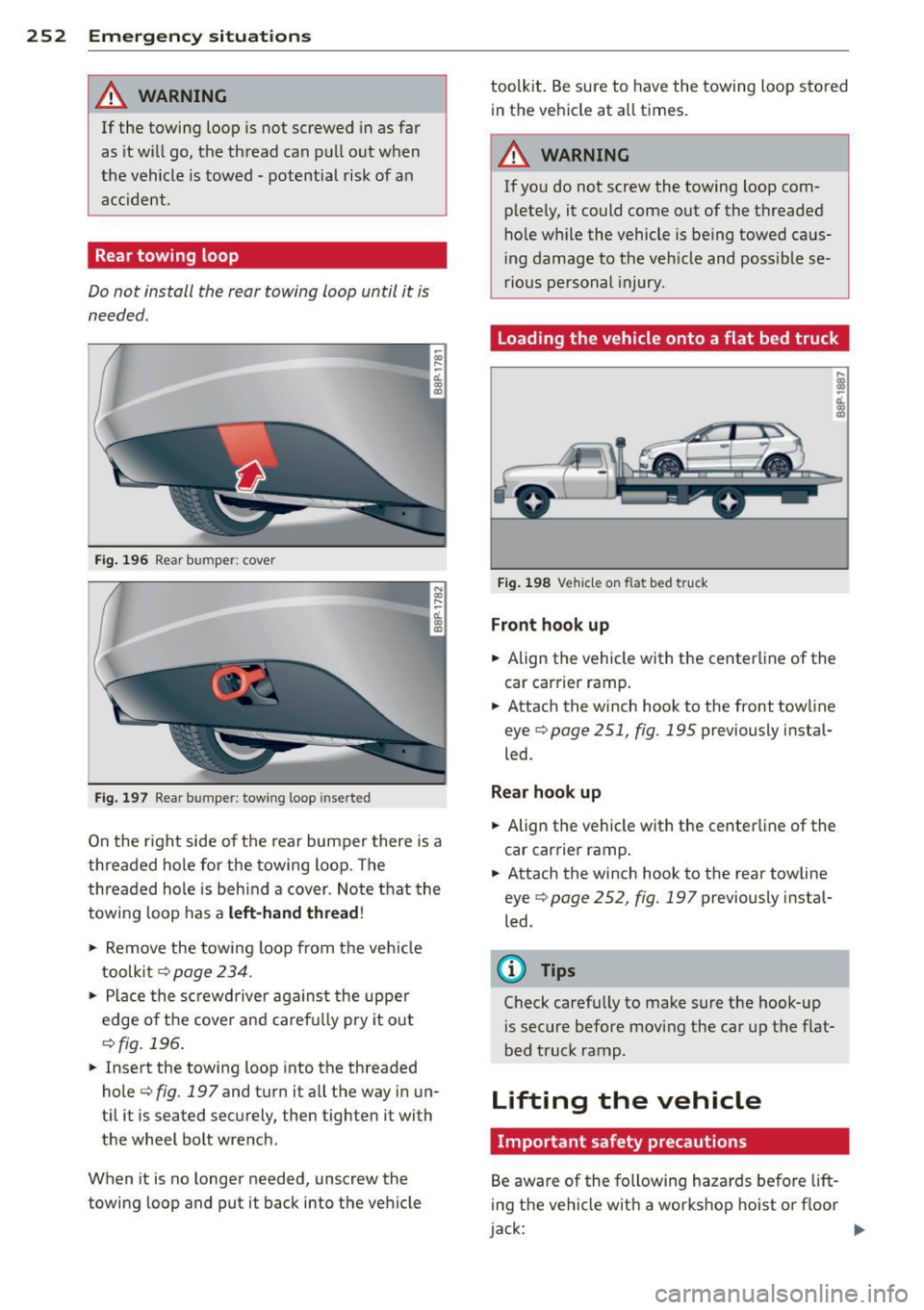
252 Emergency situations
A WARNING
If the towing loop is not screwed in as far
as it will go, the thread can pull out when
the vehicle is towed -potential risk of an
accident .
Rear towing loop
Do not install the rear towing loop until it is
needed.
Fig. 196 Rear bumper: cover
Fig. 197 Rear b umper: t owing loop inser ted
On the right side of the rear bumper there is a
threaded hole for the towing loop. The
threaded hole is behind a cover. Note that the
towing loop has a
left-hand thread!
.. Remove the towing loop from the veh icle
toolkit ¢
page 234 .
.. Place the screwdriver against the upper
edge of the cover and carefu lly pry it out
¢ fig. 196.
.. Insert the towing loop into the threaded
hole ¢
fig. 197 and turn it all the way in un
til it is seated securely , then tighten it with
the wheel bolt wrench .
When it is no longe r needed, unscrew the
towing loop and put it back into the vehicle toolkit.
Be sure to have the towing loop stored
in the vehicle at a ll times.
A WARNING
--
If you do not screw the towing loop com-
pletely, it could come out of the threaded
hole while the vehicle is being towed caus
ing damage to the vehicle and possible se
rious personal injury .
Loading the vehicle onto a flat bed truck
Fig. 198 Vehicle on flat bed truck
Front hook up
.. Align the vehicle with the centerline of the
car carrier ramp .
.. Attach the winch hook to the front towline
eye
¢page 251, fig. 195 previously instal
led .
Rear hook up
.. Align the vehicle with the centerline of the
car carrier ramp .
.. Attach the winch hook to the rear towline
eye¢
page 252, fig. 197 previously instal
led .
(D Tips
Check carefully to make sure the hook-up is secure before moving the car up the flat
bed truck ramp .
Lifting the vehicle
Important safety precautions
Be aware of the following hazards before lift
ing the vehicle with a workshop hoist or floor
jack: ..,.
Page 261 of 280
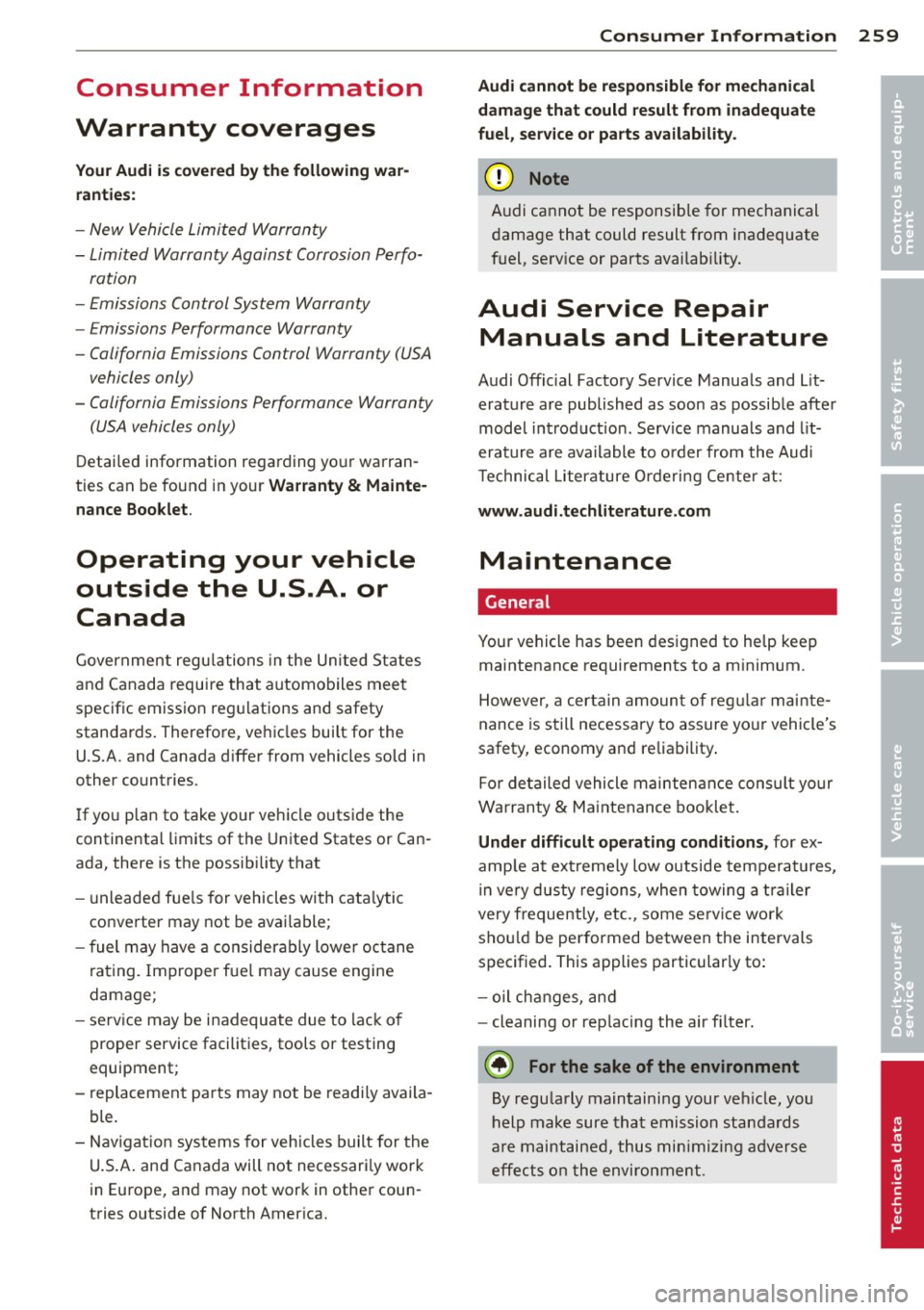
Consumer Information
Warranty coverages
Your Audi is covered by the following war
ranties :
- New Vehicle Limited Warranty
- Limited Warranty Against Corrosion Perfo-
ration
- Emissions Control System Warranty
- Emissions Performance Warranty
- California Emissions Control Warranty (USA
vehicles only)
- California Emissions Performance Warranty
(USA vehicles only)
Detailed information regarding your warran
ties can be found in your
Warranty & Mainte
nance Booklet .
Operating your vehicle
outside the U.S.A. or
Canada
Government regulations in the United States
and Canada require that automobiles meet
specific emission regulations and safety
standards. Therefore, veh icles built for the
U.S.A. and Canada differ from vehicles sold in
other countries .
If you p lan to take your vehicle outside the
continental limits of the United States or Can
ada, there is the possibility that
- unleaded fuels for vehicles with cata lytic
converter may not be available;
- fuel may have a considerably lower octane
rating. Improper fuel may cause engine
damage;
- service may be inadequate due to lack of
proper service facilities, tools or testing
equipment;
- replacement parts may not be readily availa
ble.
- Navigation systems for vehicles built for the
U.S.A. and Canada will not necessari ly work
in Europe, and may not work in other coun
tries outside of North America.
Consumer Information 259
Audi cannot be re sponsible for mechanical
damage that could result from inadequate
fuel, service or parts availability.
Q) Note
Audi cannot be responsible for mechanical
damage that could result from inadequate
fuel, serv ice or parts availab ility.
Audi Service Repair
Manuals and Literature
Audi Offic ial Factory Service Manuals and Lit
erature are published as soon as possible after
model introduction. Service manuals and lit
erature are available to o rder from the Audi
T echnical Literature Ordering Center at:
www.audi.techliterature.com
Maintenance
General
Your vehicle has been designed to help keep
maintenance requirements to a minimum.
However, a certain amount of regu lar mainte
nance is still necessary to assure your vehicle's
safety, economy and re liability .
For detailed vehicle maintenance consult your
Warranty
& Maintenance booklet.
Under difficult operating conditions, for ex
amp le at extreme ly low outside temperatures,
in very dusty regions , when towing a trailer
very frequently, etc., some service work
shou ld be performed between the intervals
specified. This applies particularly to:
- oil changes, and
- cleaning or rep lacing the air fi lter.
@ For the sake of the environment
By regularly maintaining your veh icle, you
help make sure that emission standards
are maintained, thus minimizing adverse
effects on the environment.
•
•
Page 270 of 280

268 Index
Eme rgency towing ......... .. .. .... . 251
E ne rgy management ........... .. ... 167
Ba ttery power ........... .... .. .. . 168
Dr iver notific ation ...... .. .. .. .. .. . 16 8
Eng ine
4-cylinder diesel (140 hp) ....... .... 197
4-cyl ind er g asoline (200 hp) .. .. .. ... 196
Coolant .. ... ............ .. .. .. .. . 203
H ood .. ...... ........... .. .. .... . 194
Pr ehea ter . . . . . . . . . . . . . . . . . . . . . . . . . 86
Start ing . . . . . . . . . . . . . . . . . . . . . . 89, 90
Starting with j umper cab les . ..... .. . 248
Stopping . . . . . . . . . . . . . . . . . . . . . . . . . . 91
E ng ine compartmen t ................ 196
Safety instruc tions .......... .. .... . 194
Working in the engine compar tment .. 194
Eng ine coolant system ........... .... 203
Adding coo lant ............ ... .. .. . 204
Chec king coolan t leve l ..... .. .. .... . 204
Che cking the eng ine coolant leve l ..... 204
M alfunct ion . . . . . . . . . . . . . . . . . . . . . . . 17
Radiator fan . .. .. ..... ... .. .. .... . 205
E ng ine coolant temperature
Gauge ... .. ................ ... .. .. 11
Eng ine data .. ............... ...... . 257
Engine fault Warning light .. .. ..... ... .. .. .... .. 20
E ng ine hood
C lo sing .. .. ............. .. .. .. .. . 194
Release lever . ........... .... .... . 194
Releasing and open ing . ... .. ... ... . 194
Eng ine malfunction (diesel engine)
War ning light ............ .. .. .... .. 20
Eng ine oil . ............... .. .. .... . 197
Adding .. .. ............... .... .. . 200
Addit ives . .. ................ ... ... 200
C hanging .. ... .... ...... ... ... .. . 20 1
Chec king the eng ine o il level .. .. .. .. . 200
Di ese l eng ine ............ .. .. .... . 20 2
I ndications and con ditions req uiring ex-
tra check ing . .. .. ..... ... .. .. .... . 200
Oil consumption .. ..... ... .. .. .... . 199
Oi l grades . .... . ...... ... .. .. .... . 197
Recommended oil check intervals ..... 200
Specification and viscos ity .... .. .... . 197
Specifications Diesel engine .. .... ... 202
Specifications gasoline engine .. .. ... 197
Tempe ratu re d isplay ...... .. .. .. .. . . 31 E
ngine oi l leve l . . . . . . . . . . . . . . . . . . . . . . 20
E ngine o il pressu re (malfunction) ....... 16
Engine oil sensor defective ............ 20
En gine preheate r .................... 86
C onnect ing . ..... .. ... ..... ... .. .. . 86
E ngine speed limitation . . . . . . . . . . . . . . . 20
Environment Break-in per iod . .. ............. .... 169
Catalytic converter ............. .... 170
Diesel particulate f ilter ............ . 171
D ispos ing of your veh icle battery ... .. 210
D riv ing at high speeds .............. 172
D riving to minimize pollution and noise 171
F uel ............................. 192
F uel economy . . . . . . . . . . . . . . . . . . . . . 171
Leaks under your vehicle ..... ... .. .. 194
Letting the vehicle stand and warm up . 172
Proper d isposal of drained bra ke fluid . 206
Proper disposal of drained eng ine cool-
ant ............................. 204
Proper d isposal of drained eng ine
o il . . . . . . . . . . . . . . . . . . . . . . . . . 200, 201
Recycling used engine oil ............ 200
U nleaded fuel . ... ................ . 189
Wha t shou ld I do w ith an o ld b att ery? . 210
EPC
refer to E lect ron ic power co ntrol ... .. . 19
Event Data Recorder (EDR) ........ .... 161
E xh aus t tai l pipes
Cleaning .. .... .. ............. .... 183
Expansion tank .. .. ................ . 204
Exterior mirrors Adjusting . . . . . . . . . . . . . . . . . . . . . . . . . 53
Dimming .......................... 54
Heating ........................... 53
F
Fahrenheit
Switching between Fa hrenhe it and Centi-
grade ....... .... .... ........... .. 83
F an
Adjusting the fan speed ...... .... . .. . 83
Climate controls ............... .. .. . 83
Radiator ......................... 205
Page 273 of 280
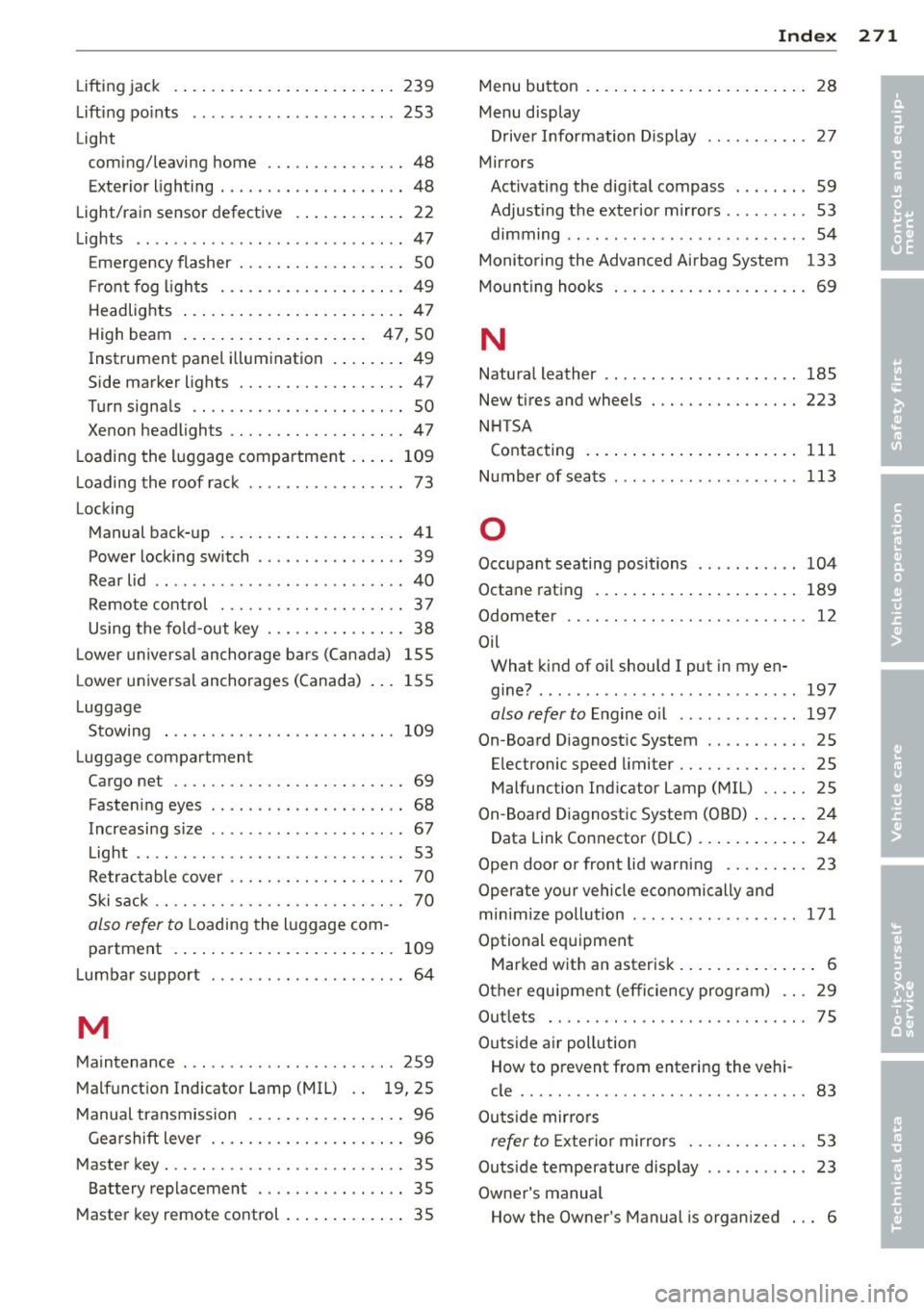
Lifting jack .... .... .... ... .. .. .. ... 239
Lifting po ints ...................... 253
Light coming/leaving home ............... 48
Exterior lighting .......... .......... 48
Light/ra in sensor defective . ... .. .. .. .. 22
Lights .. .. ..... ........... ...... ... 47
E mergency flasher . . . . . . . . . . . . . . . . . . SO
Fr ont fog l igh ts .......... .... .. .. .. 49
H eadlig hts ... .... .... ... .. .. .. .... 47
High beam . . . . . . . . . . . . . . . . . . . . 47, 50
Instrument panel i llum ination . ... .. .. 49
Side marker lights ........ ...... .... 47
Turn signals .. ........... .. .. .. .... 50
Xeno n headlights ................... 47
L oading the l uggage compartment . ... . 109
L oading the roof rack . . . . . . . . . . . . . . . . . 73
Locking Manual back-up .......... .. .. .. .. .. 41
Power locking switch . . . . . . . . . . . . . . . . 39
Rear lid .. ..... ........... ...... ... 40
Remote control . . . . . . . . . . . . . . . . . . . . 3 7
Using the fo ld-out key . . . . . . . . . . . . . . . 38
Lower universa l anchorage bars (Canada) 155
L ower universa l anchorages (Canada) 155
L uggage
Stowing . .. ..... ....... .... ... .. . 109
Luggage compartment
Cargo net .. ............. .... .. .... 69
Fasten ing eyes .................. ... 68
Increasing size ... .. ... ... .. .. .. .. .. 67
L ight . . . . . . . . . . . . . . . . . . . . . . . . . . . . . 53
Re tractable cover . . . . . . . . . . . . . . . . . . . 70
Ski sack . . . . . . . . . . . . . . . . . . . . . . . . . . . 70
also refer to Loading the l uggage com
partment . . . . . . . . . . . . . . . . . . . . . . . . 109
L umbar support ..................... 64
M
Maintenance ............... ...... .. 259
M alfunction Indicator Lamp (MIL) . . 1 9, 25
M anual tra nsmission ................. 96
G ea rshift lever ........... .. .. .. .. .. 96
Master key . ................ ...... ... 35
Battery replacement ................ 35
Master key remote control ... .. .. .. .. .. 35
Inde x 271
Menu bu tton . ..... .. . .. .. ..... ... .. . 28
Menu display Drive r Infor mation Display ........... 27
Mirrors Activating the dig ital compass ........ 59
Adjus ting the exterior m irrors . . . . . . . . . 53
dimming ........ .. ................ 54
Monitoring the Advanced Airbag System 133
Mo unti ng hoo ks . . . . . . . . . . . . . . . . . . . . . 69
N
Natura l leather .. .. .. ..... .......... 185
New t ires and wheels ................ 223
N HT SA
Co ntacting . ... .... . ... ...... ... .. 111
Number of sea ts ... .. ............... 113
0
Occupant seating positions .......... . 104
Octane rating ....... . .. .. ..... ... .. 189
Odometer . . . . . . . . . . . . . . . . . . . . . . . . . . 12
Oil Wha t kind of oil should I put in my en-
gine? ........ ... .. ............... 197
also refer to Engine o il ... ... ..... .. 197
On-Board D iagnost ic System ........... 25
E lectronic speed limiter .............. 2S
Malfunction Indicator Lamp (MIL) ..... 25
On-Boa rd Diagnostic System (OBD) ... .. . 24
Data Link Connector ( DLC) .... ... .. .. . 24
Open door o r fron t lid wa rn ing ......... 23
Operate your vehicle economically and
minimize pollution ... . .. .... ...... .. 171
Optional eq uipment
Marked with an asterisk . . . . . . . . . . . . . . . 6
O ther equ ipment (e fficiency program) ... 29
Out lets ............................ 75
Outside ai r poll ution
How to prevent from entering the vehi-
cle ............................... 83
Outs ide mir ro rs
refer to E xterio r mi rro rs . . . . . . . . . . . . . 53
Outs ide temperature disp lay ......... .. 23
Owner's manual How the Owner 's Manual is organ ized ... 6
•
•